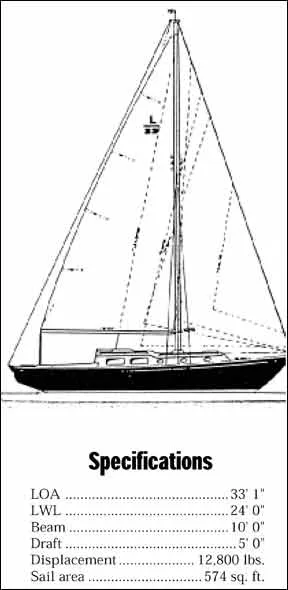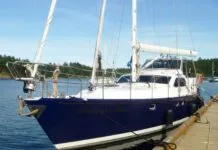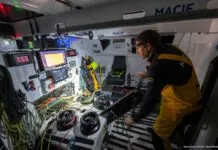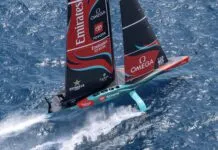The 1960s produced a whole passel of smaller production yachts of a similar style designed by the likes of Phil Rhodes, Carl Alberg, Olin Stephens, and Ted Hood. These are quite traditional boats with moderate overhang fore and aft, modest topside height, full keel, heavier displacement, low aspect rig, and perky sheerline.

One of the most popular and typical of this style of boat is the Luders 33 designed by Bill Luders and built by Allied Yachts of Catskill, NY, from 1966 to 1974. Luders, a former boatbuilder as well as designer, designed the 1964 America’s Cup contender American Eagle, a fleet of 44′ yawls for the US Naval Academy, and the Sea Sprite 34.
It is unfortunate that the builder of the Luders 33, Allied Yachts, had such a troubled existence, struggling for survival from the early 1970s until the firm finally succumbed for good in 1981. In its heyday in the late 1960s, Allied built some popular boats including the 35′ Seabreeze, the 39′ Mistress, and the semi-classic Seawind 30 (later the 32′ Seawind II) as well as the Luders 33.
The problem for the used boat buyer in considering a boat from a defunct builder is compounded in the case of Allied. In its struggle in its latter years the quality of the boats Allied built became inconsistent. This is more notable in the detailing and finish work than in basic construction, but it is a factor to consider. However, this should not be as much a problem for buyers of the 33 as for later Allied products.
A Close Look at the Boat
Throughout its nine year production run, a bit more than 100 Luders 33s were built. Still, like such similar boats as the Alberg 30, the relative scarcity and traditional styling have made it a bit of a cult object.
With her short waterline, heavy weight, short rig, large amount of wetted surface, and small prop in aperture, the 33 can hardly be termed a spritely performer under either sail or power. For instance, against the more modern (designed in 1968) but otherwise comparable Tartan 34, the 33 gives away more than 20 seconds per mile under PHRF.
At the same time the 33 is no slouch when sailing among heavier boats of her type. At her introduction, much was made of her hull design having been tank tested; indeed in the later 1960s, 33s compiled a creditable racing record. At their best in winds of 10 to 15 knots and smoother seas, a number are still successfully raced in PHRF events in the Northeast where winds are typically moderate. Although short, the rig with its big mainsail and masthead foretriangle provides plenty of sail power; however, a good reefing system is needed to prevent overpowering in a breeze. One advantage of the large mainsail is the ease with which the boat can be handled under mainsail alone, in contrast to the difficulty of sailing a modern tall, skinny mainsail design without a headsail.
For power the 33 will have either the original Gray 25 hp gas engine, the 27 hp gas Palmer (after 1967), or a small retrofitted diesel. All can provide enough push ahead, but the prop location and size hurts backing down.
Belowdecks the 33, like so many of boats of her size and type, is decidedly cramped compared to more recent 33-footers, although it’s spacious for a boat with a waterline length of merely 24′.
The forward berths are comfortable; the upper or pilot berth in the main saloon is handier as a catchall than it is for sleeping; the pull-out transom berth is not bad as either a seat or a berth; and the “convertible dinette” is just fine for those who want to have a double berth and who don’t object to the compromise.
Other than the dinette, the layout of the 33 is definitely “traditional” with an athwartships galley aft, a small head, and an icebox lid that doubles as a chart table. The raised cabin trunk with large windows was a popular feature in production boats of this era, providing headroom, light, and cockpit protection.
The interior decor of the 33 was intended to be plain and functional, although a number of owners report dressing it up with wood, replacing Formica surfaces. The quality of the joinerwork and finish varied somewhat during the production run but in general can be deemed about average.
The cockpit is short by modern standards but has more abundant stowage space in seat lockers and lazarette than in later boats fitted with quarterberths and cockpits extending to the transom. The original design was for tiller steering, but many 33s have been subsequently fitted with wheel steering. Owners report wheel steering preferable for ease at the helm but are divided on whether it should be located forward or aft in the cockpit.
The decor might be plain, but there seems no question that the basic construction of the 33 is rugged. The weight of the boat apart from ballast amounts to a whopping 8,000 pounds, a weight that today is closer to the all-up displacement of boats with waterlines 2′ to 4′ longer.
What to Look For
As with so many boats built more than, say, 10 years ago, weaknesses such as inadequate hull-to-deck joints, poor bulkhead tabbing and the like have long since become apparent and should be found in any professional survey. What may be less apparent in the 33 is deck and cabintop delamination—separation of the laminate from the balsa core.
Similarly there are reports of gelcoat problems (crazing, voids, etc). And, as with any deck-stepped mast the step and under-deck support system should be carefully checked. So too should the rudder and its hangings.
In the era in which the 33 was built, strength was often obtained by using heavy fiberglass scan’tlings in place of good construction engineering, one result of which is sloppy glasswork although not necessarily a weaker hull structure.
With a boat of the type of the 33, upgrading and refurbishing seems a worthwhile investment. Performance can be markedly improved with slab reefing, a roller traveler, good sails, etc. The looks of the boat can be dramatically enhanced with well finished exterior wood trim and refinished gelcoat surfaces. Thus, in considering used 33s, look for those in which past owners have worked—and spent—to make their boats better. The alternative is to look for a sound but unimproved model at the right price and plan to invest in bettering her. Finding the right one may take time and effort, but they do come on the market. As one owner put it, “Look for three years and close the deal in three minutes if you find her.”
Conclusions
Given the price on the used boat market of similar “traditional” boats such as Cape Dories, Sea Sprites, and Albergs, the Luders 33 strikes us as a most promising alternative. The 33 sails better than most of her full keel/short waterline kin, is built to last as long, and should represent good equity. In return, the 33 may need some refurbishing, perhaps a new diesel engine if not already retrofitted, but the result is a superb boat at a price that should be well below that of other production boats of her type.


































